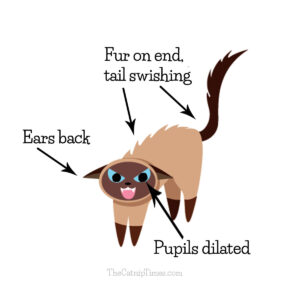Have you ever been curious about why cats will lick and then bite you? It’s a strange behavior, and one that doesn’t seem to make much sense. Is your cat trying to tell you something? Are they angry with you? Or are they just plain crazy?
My cat, Princess Amazing, is the biggest culprit of this habit. After I get in bed each night, she jumps up and starts meowing and circling on my bed, until I pet her. She starts purring, her eyes close softly and eventually, she sits down. If I stop petting, I get yelled at. So I do as I’m told and I continue. But then after maybe another 5-10 minutes of me gently petting her while watching TV, she abruptly bites, hisses and stares back at me like I’ve committed some awful offense. And then she leaves. Clearly she’s just telling me she’s had enough.
But first here are some signs your cat isn’t in a good mood
First, let’s understand some common cat body language that signals that your cat is in a bad mood.
Ears
Pay attention to the position of your cat’s ears. If they’re flat or pointed backward, your cat isn’t feeling happy.
Pupil size
Also, notice the size of your cat’s pupils. If they’re dilated (large) then your cat may be stressed.
Tail and fur
If your cat’s tail is down, or curled beneath them, or their fur is standing on end – don’t engage with your cat. Also, if your cat is swiftly swishing his tail back and for, then he’s probably not in a good mood.

If you’ve identified that your cat is in a bad mood, back off and give him or her some space. Never punish or yell at your cat and don’t take it personally unless you’ve done something to annoy your kitty.
Now let’s explore some theories about why cats lick and then bite. We’ll take a look at what this behavior means, and how it can be interpreted. So if you’ve ever wondered what your kitty is trying to say, read on!
Theory 1: It’s a way of communicating
There are a few different theories as to why cats lick and then bite. One theory is that it’s a form of communication. When a cat licks you, they may be trying to show you affection, “I love you.” However, the biting can also be seen as a warning – “Don’t get too close, or I might bite you!” In other words, your cat is saying – “I like you – but don’t get greedy with my love – or else.”
Theory 2: It’s a form of play
Another theory is that this behavior is a form of play. Cats are natural hunters, and the licking and biting may be a way for them to practice their hunting skills. This theory makes sense when you consider that kittens often engage in this behavior when they’re playing with each other.
NOTE: Never use your hand as a plaything or toy. Your cat will associate your hand with playing and you’ll encourage them to attack your hand. And worse, if a guest or child comes to your home, everyone’s hands are fair game to your cat. And while you might not mind it, your guest may have a different opinion. Cat bites are no joke and you could be putting your cat’s life and your guest’s life in danger.
Theory 3: They’re overstimulated
One final theory is that some cats may lick and bite because they’re overstimulated. This can happen if a cat is petted for too long, or if they’re feeling anxious. If you notice your cat starting to lick and bite more frequently, it’s important to take a step back and give them some space.
Theory 4: They’re grooming you
There’s one final reason why your cat may lick and bite you, and that’s because they’re grooming you! Cats are fastidious creatures, and they love to keep themselves clean. But they also like to help their fellow cats and humans out by giving them a good lick down. You can frequently find two cats licking each other and then biting – and it often ends up in a tussle! So if your kitty is licking and biting you, they may just be trying to groom you!
So what does all this mean? Cats are complex creatures, and their behavior can often be difficult to interpret. If your cat is exhibiting this behavior, it’s best to observe them closely and see if you can figure out what they’re trying to tell you.
Of course, this behavior can also be a sign of something more serious, like anxiety or stress. If you’re concerned about your cat’s licking and biting, it’s always best to consult with a veterinarian. They can help you determine whether there’s an underlying medical condition causing this behavior.
Does your cat lick and then bite you? Tell us in the comments!
